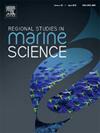A temperate gorgonian coral garden in the shallow sublittoral off Buenos Aires, Argentina
IF 2.1
4区 环境科学与生态学
Q3 ECOLOGY
引用次数: 0
Abstract
This study explores the previously unknown Banco Patria, a rocky reef located near Mar del Plata, Argentina. The reef stands out for its unique composition – coquina, a sedimentary rock formed from shells and sand – in contrast to the neighboring quartzite outcrops. SCUBA dives (26–32 m depth) were conducted to characterize the reef's topography, geology, and biological community. This reef is dominated by the unbranched, azooxanthellate soft coral Tripalea clavaria, reaching up to 240 colonies per square meter. This represents the first record of a coral garden in shallow waters of the Argentinean Continental Shelf (Buenos Aires). Tripalea clavaria densities are considerably lower in shallower areas and on quartzite outcrops. The Banco Patria reef community is characterized by a high abundance of filter feeders, including gorgonian, hydroids, bryozoans, and sponges. They play a crucial role in nutrient cycling and provide food for other members of the community. Notably, blue mussels, ubiquitous in neighboring reefs, are entirely absent at this reef. The complex topography of Banco Patria provides a haven for a diverse assemblage of fish species, which utilize the reef's intricate structure for feeding, refuge, and reproduction, including typical reef fish such as the Brazilian sandperch, the Patagonian grouper, and the cocherito and big transient school of silver and red porgy. The reef's unique composition, substrate characteristics, and distinctive community highlight its ecological significance. Monitoring programs, educational initiatives, and government action are crucial to safeguarding this unique and potentially vulnerable reef ecosystem.
求助全文
约1分钟内获得全文
求助全文
来源期刊

Regional Studies in Marine Science
Agricultural and Biological Sciences-Ecology, Evolution, Behavior and Systematics
CiteScore
3.90
自引率
4.80%
发文量
336
审稿时长
69 days
期刊介绍:
REGIONAL STUDIES IN MARINE SCIENCE will publish scientifically sound papers on regional aspects of maritime and marine resources in estuaries, coastal zones, continental shelf, the seas and oceans.
 求助内容:
求助内容: 应助结果提醒方式:
应助结果提醒方式:


